Episode 209
What you’ll learn in this episode:
- Why it’s harder to find quality vintage and modern costume jewelry today than in years past
- How Rosie secured a spot as an appraiser on Antiques Roadshow
- What Rosie looks for in the pieces she collects, wears and sells in her shop
- Where the term “costume jewelry” came from and its history
- Why Rosie is one of the only people in America who will repair costume jewelry
About Rosie Sayyah
Rosie Sayyah has been selling and repairing vintage and estate jewelry from her shop, Rhinestone Rosie, in Seattle since 1984. In the early 1980s, Rosie felt her family tradition of dealing in antiques calling to her. Upon leaving her corporate career in television, she decided to open a jewelry store that not only had unique, exciting items for sale, but also where she could restore greatness to jewelry that had fallen into disrepair. Teaching herself about vintage costume and estate jewelry culture and repair through books, hobby shops, and hands-on experience, Rosie has become a national expert in the field. In the late 1990s, she began appearing regularly on “Antiques Roadshow” on PBS TV and continues today as one of their expert appraisers.
Photos:
Three images of before, stone choices and final repair
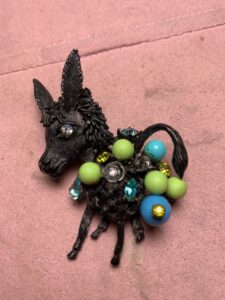
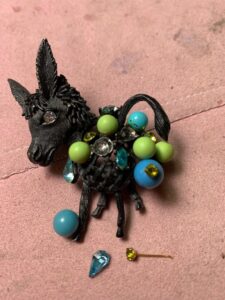
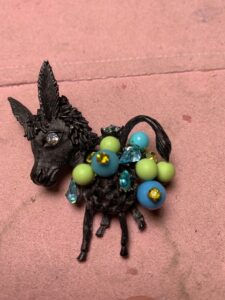
An acrylic purse handle becomes an avant- grade necklace by using one of these two chains.
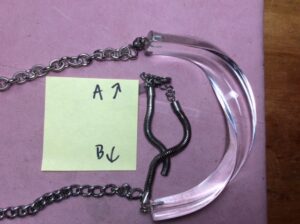
This pin needed a stone in the bottom. We gave the client two choices
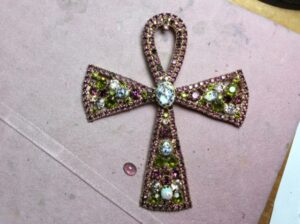
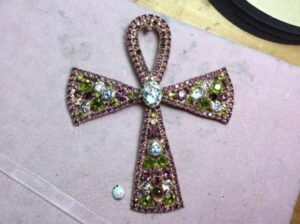
This jade necklace came in with knots in between that were too widely spaced.
We do all manner of restringing with a variety of materials.
This necklace was restrung with tightly knotted green silk thread
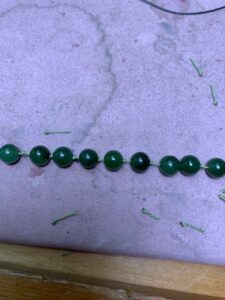
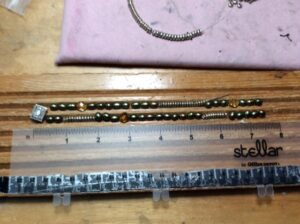
A Bakelite horse head receives a new bridle rein.
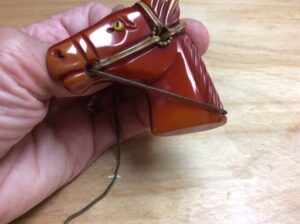
We have thousands of pieces for sale in the store also. Our inventory goes from 1870 to 1970 and newer!
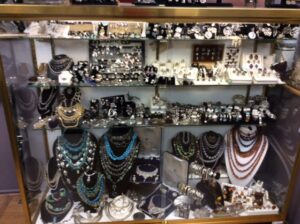
Most of our earrings for sale are either clip on or screwbacks, but we can change them to pierced for you. Or, bring in your own to have changed.
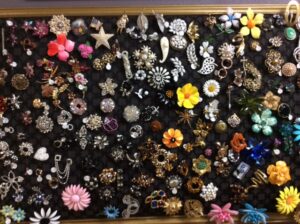
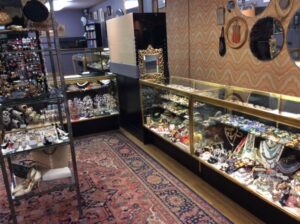
Restyling a bracelet by mixing two elements to create a new design
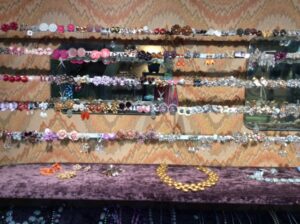
This is our Seattle location for 40 years, since 1984. We also have an online “store”
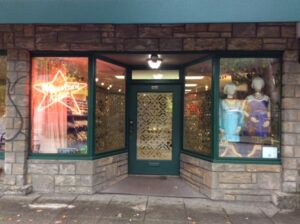
Additional resources:
Transcript:
Rosalie Sayyah, aka Rhinestone Rosie, first got jewelry lovers’ attention as an appraiser on Antiques Roadshow. But she has earned her customers’ loyalty for her ability to repair vintage costume jewelry and perfectly match missing rhinestones when no one else can. She joined the Jewelry Journey Podcast to talk about why so few jewelers will repair costume jewelry; what she looks for in the pieces she buys; and how to start a costume jewelry collection of your own. Read the episode transcript here.
Sharon: Hello, everyone. Welcome to the Jewelry Journey Podcast. This is the second part of a two-part episode. If you haven’t heard part one, please head to TheJewelryJourney.com.
Today, I’m talking with Rhinestone Rosie. You may already be familiar with Rosie. She has her own retail outlet in Seattle, and she does a strong mail order business. You may be familiar with her by seeing her on Antiques Roadshow giving the price of vintage jewelry to people who want to know. Welcome back.
Sharon: Why don’t they make them anymore?
Rosie: I don’t know exactly why, but take a company like Schreiner. They’re so collectable. Most of the stones that were put in that jewelry in the 50s and 60s came from a secret stash that he had from the early 20s and 30s. They just don’t make them anymore. A lot of new jewelry is Lucite, plastic stones, not glass, not crystal, so there is a problem with soldering, of course.
Sharon: That’s interesting. I didn’t think about that. Do you ever have a problem letting something go if somebody brings in a whole collection, and you’re going to sell 9% of the pieces, but you want one that you want to hold onto for whatever reason?
Rosie: I’m not sure I understand that question.
Sharon: Do you ever have a problem or a question of letting something go when somebody brings in 99 pieces?
Rosie: I want to buy it and they don’t want to sell it?
Sharon: Or they want to sell it and you think you should be selling it, but you can’t let it go, so you buy it?
Rosie: Of course, yes. There are pieces that never hit the sales floor, you bet.
Sharon: That’s interesting. Do you teach classes on vintage jewelry and rhinestones? You said you do a lot of talking.
Rosie: The only thing I’ve done lately has been the talks. I used to do classes in my shop. I would drag chairs from the tavern down the block. But we’ve rearranged the floor plan of our shop, and it doesn’t suit itself very well. I’m still very, very aware of Covid, I’m sorry. I do wear a mask when I’m in my shop. People don’t have to wear a mask if they come in. That’s why we’re only open three days a week, to limit exposure. I probably wouldn’t do classes that way for a while. I’ve taught a few one-on-one people how to repair, especially soldering. People wanted to learn, but it’s just practice.
Sharon: It is hard. That’s a good way to look at it. I don’t have the patience for that, but you’re right, it is practice. You say that you’re self-taught. Have you taken any makers’ classes besides reading books, any education?
Rosie: The only thing I’ve done is I’ve gone to a lot of—there were conventions and seminars back East and also on the West Coast over the years. Through the years, I’ve attended a lot of those, but it wasn’t repairing. It was just learning more about what things are, what they look like and what I want them to look like at the end. Both of my parents were older, so I grew up with an atmosphere not from the 50s and 60s, but the 30s, 40s, 20s. It just soaked into me how things looked, what they liked.
I’ve learned from other people, other dealers, about what they like, what they sell and sharing that information. I’ve also learned from my contemporaries on the Roadshow, invaluable stuff, but no classes. There is really nobody that could teach me that because in schools they don’t do what we do. I don’t use an open flame torch; I use a pencil soldering iron, various glues. It’s tricky. You can easily melt a piece and destroy it for a customer. You have to be very, very careful.
Sharon: Has that ever happened to you, that you’ve destroyed a customer’s piece accidentally?
Rosie: No, it’s been more of my own. I do a lot of repairing on my own. I’ll buy a broken piece and fix it. I’m knocking on wood here. I haven’t had that problem, totally destroying something.
Sharon: When you refer out to people who work with gold, let’s say, do they ever look down on you or look down on what you’re doing because it’s not real?
Rosie: If they do, they’d better not tell me because I’m sending them business. But I get that feedback a lot from people. They say they’ve taken this jewelry into their jeweler and they pooh-pooh it. “No, no, we can’t fix that. We don’t work with that stuff,” so they send them to me.
Sharon: I was thinking they say, “We don’t work with that stuff.” It’s too cheap or it’s not real or it’s whatever.
Rosie: Yeah, whatever it is. I don’t know. I think that’s not a good customer relations attitude.
Sharon: I think that makes a lot of sense. Did you have any—I’ll use the word compunction. Did you have any reservations or compunction about centering your life around costume jewelry and rhinestones?
Rosie: If you saw my house, you’d realize that I’m a major gardener. I’m very physical and active. I walk a lot. I read a lot. But I don’t bring my stuff home per se. I don’t have a storeroom here in my house. The pictures behind me are my husband’s. He’s traveled all over the world taking photographs. It is a life built around it. That’s fine and that’s who I am, but I’m also a different person that is totally devoid of any kind of sparkle.
Sharon: What is your favorite kind of costume? You mentioned 50 watches. What is your favorite kind of jewelry?
Rosie: I like necklaces. I think a necklace can transform the whole image of the outfit you have on and the way you feel about yourself. It’s one of the things we can see when we have it on. We can see rings, watches, bracelets. We can’t see earrings. We have to look in a mirror. But a necklace, it can be a real changer to you. I know a lot of people wear necklaces 24/7. I don’t. I don’t have a little gold chain on with a little diamond or anything like that, but I like necklaces and brooches. I wear more jackets in the winter, so I wear a lot of brooches, but I wear necklaces with my outfits year-round, so that would have to be it. I also wear rings and watches.
Sharon: What would you think if someone wanted to collect costume jewelry or rhinestone jewelry? Where should we start? Is there somebody we’re not looking at?
Rosie: I would say buy what appeals to you and wear it and see if you like it. I don’t like to focus anybody on a certain name or area. Most people, when I ask them how they started or how they collect, they say, “Oh, I buy these things that shine.” That’s one way to do it. If you happen to find a name you like, I would say you can focus on those pieces, but I don’t try to steer anybody in any certain direction. I just say buy what you like and enjoy it. It doesn’t matter what anybody else says to you. That’s how I buy.
Sharon: Do you think the stuff that is around today is as long-lasting as the stuff of yesteryear?
Rosie: No, not at all. Glue and plastic and that kind of thing, the way they’re made, no. Back in the 40s and 50s, these pieces were all hand-set. They were all prong-set or glued in individually if they were not prong-set. Today, it’s more mass hot glue gun, stick them on, pile the stones on, and they just fall off. The settings are not strong. I would agree with you. Contemporary jewelry does have some issues.
Sharon: I’ve been stopped sometimes in a good way, like, “Oh, that’s a pretty necklace. It’s shiny.” I don’t buy it, but I don’t not buy it because of the money. In my head, I think, “Oh, that won’t last that long,” not because it’s not made well, but because it’s a contemporary piece. Do you know what I mean?
Rosie: I do know what you mean, yes. People go to Hawaii and buy the nut necklaces. It’s what I call tourist quality. They even did that back at the turn of the century. When people were on the Grand Tour, they would buy little pieces of jewelry. They’re better made than our tourist quality today, but it was still way lower quality. That’s when the industrial revolution came in and made things able to be mass-produced. Then they could sell it better. Not just the aristocracy would have jewelry, but anybody could have jewelry. That really did change, too. The commoner can have a little pin or whatever.
Sharon: The necklace you have on has big, bold stones. Is that the way it started? Did people have less conspicuous things, and then they became used to that and started having things that are big and bold?
Rosie: Yes, in the 50s after the war, people wanted to celebrate the American way. This is America. This is screaming, “We are big and bold!” If you think of cocktail parties, cocktail rings, your jewelry wouldn’t just have one necklace. This necklace has a matching bracelet, earrings and a brooch and maybe even a ring. The women would be totally decked out in this. I think it’s totally an American quality, really out there, very proud of what they have, big and bold. That’s what happened in the 50s and 60s, but we didn’t get our ears pierced until the 60s. We were still wearing the clip-on earrings, because a loose woman would have her ears pierced. That was funny.
Sharon: My mom would say, “Whatever.” Have you ever seen a piece that’s too—I want to use the word gaudy without saying it’s gaudy, but it was too big and bold?
Rosie: Oh yeah, I have. Something about it would be a little demonic or something, but it had those elements to it. Oh yeah, I’ve seen that, but that’s O.K. It’s just an expression of what that person wanted to make, and I can totally understand that. There were two guys, DeLizza and Elster, and we call it D&E Jewelry. They just started making stuff they liked, and that’s usually some of the best jewelry, I think. You just let it flow. Make what you like.
Sharon: I didn’t mean to interrupt, but they were D&E and they segued to Juliana?
Rosie: Juliana, I think, and I might be mistaken, was the name of one of their daughters. They didn’t sign the jewelry. It only had paper tags, but there are certain industrial components to the jewelry that I can identify that it’s by D&E or Juliana. We call it Juliana. Schreiner is another company. There are certain elements of Schreiner jewelry you can identify if it’s not signed. Miriam Haskell had a certain quality to her jewelry that you could identify. There are other names, too. Trifari had a certain quality. Even though they had different designers, there was always a certain quality to the jewelry. You could pick it out. When I go to a sale, I can narrow in and get through all the other stuff and pick out certain pieces that I want.
Sharon: Yeah, with costume jewelry, the challenge is that so much is not signed.
Rosie: Yes.
Sharon: It is. That’s interesting, that you can pick out the ones you think are different makers or you can tell from the way they’re made.
Rosie: Exactly. Sometimes, the first thing I do is look at the back of the piece. I tell people, “Look at the back and see how it’s made. It’ll give you some clues.”
Sharon: What are you looking for?
Rosie: I’m looking for what kind of catch it has, the hinge and stem, the material it’s made of. Is the back hand-polished? Is it not hand-polished? How heavy is it in my hand? What type of stones did they use? How are the stones set? Are they fully pronged or is it just a glued-in stone? Those little clues tell me a lot.
Sharon: Do you think that’s over with? All the manufacturing techniques you’re talking about, do you think nobody’s doing them?
Rosie: I’m not up to speed on exactly—I know Iradj Moini, he had some fabulous, well-done pieces. He used all the old techniques, and that’s the newest designer I have. A lot of stuff is being made in China. Joan Rivers’ stuff is being made in China. J. Laine is being made in China. They’re good, but they still don’t have all of that total, hand-touched stuff. Heidi Daus, I like her pieces. They’re very colorful and bold. I got a whole estate of it, and they sold like boom, boom, boom. People were like, “Wow, I like this!” She uses bold colors, but they’re not prong-set; they’re just glued in. I have to say that fine jewelry maybe has some of those elements of the manufacturing process, but costume jewelry is slowly going away from that. They can’t afford to do it.
Sharon: Yeah, I can understand.
Rosie: No, mm-hmm.
Sharon: Especially with what’s coming in from China, it’s hard to tell what’s real and what’s a copy.
Rosie: Yeah. I do like a lot of stuff coming out of India. They do a very good job of stone setting and stone cutting. I like some of those contemporary pieces, but I’m just not—maybe somebody out there can give me a little heads up and tell me who’s doing what. I would definitely appreciate that.
Sharon: If we’re not in Seattle, you work nationally, don’t you? You work nationally and you have a website.
Rosie: Oh yeah, people can mail us stuff. I don’t go look at something in Alabama. I’m not going to travel to look at your collection, but you can always send me an email or a picture and ask questions or if you want something repaired. Definitely, go to our website, get the address, boom, mail to us. When I receive it, I look at it. I get you on the phone. I like to talk to you on the phone and say, “O.K., I’ve got your stuff. This is what I can do. I can’t do this.”
I have a lady in New York. She sells antique purses. She’s been a customer for years. She’ll send me huge boxes of purses. I have two hatpin collectors, dealers. They send huge boxes, one back East. Actually, I think she’s in Washington, too. Anyway, dealers have no problem at all once they discover what we do, because it’s very time-consuming to do and our prices are quite reasonable.
Sharon: Yeah, they are.
Rosie: Even the pieces we sell, the prices are very reasonable compared to a lot of other dealers. It’s like, “What are they thinking when they put that price on there?” If it’s a really cool and very rare piece, we will put a higher price on it, but people do buy it. That’s why we’re still in business after 40 years. They find us when they need us.
Sharon: That’s true. They probably need you very often.
Rosie: Yes.
Sharon: If we want to keep on top of what you have, would we look at the website? Would we look at Instagram? Do you not change things?
Rosie: The pieces online are not in the shop. They can be brought in. It’s a very small, limited, vetted collection that goes online, but in the shop, there are thousands and thousands and thousands of pieces. Just about anything you would need or want we could probably find for you.
Sharon: There’s a limited amount that you find on the website.
Rosie: Right.
Sharon: So, I would call you up and say, “I have a green dress and I need something, What do you think?”
Rosie: Oh boy! In that case, I could shoot you a picture of several things and tell you how much they are. If you’re interested, we’ll ship them out to you.
Sharon: I wish you had more on the website.
Rosie: It’s a lot of work to do a website. My daughter does all that. I would imagine if I ever retired, that’s probably how I would get rid of most of my inventory. I’d have to rethink and redo that. But now, if you really want to see what we have, you come into the store.
Sharon: That’s good to know.
Rosie: It’s interesting though, Sharon, my annual visitors, they come. I’m on their bucket lists. They come once a year. They fill up on their glitz and they’re very happy. We have cruise ships coming out of Seattle. They go to Alaska and people come in and say, “My husband’s not here. He could care less, but you’re on my list when I’m in Seattle.” People will come.
Sharon: It’s true. I think you’re the only person on our bucket list. If I had a written bucket list, that would be it. Thank you for being here today. We really appreciate it. I hope to get to Seattle soon.
Rosie: Thank you. Thank you so much. I hope to see you in person soon, too.
Sharon: We will have photos posted on the website. Please head to TheJewelryJourney.com to check them out.
Thank you again for listening. Please leave us a rating and review so we can help others start their own jewelry journey.

